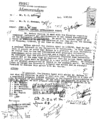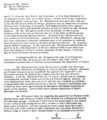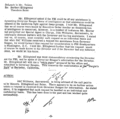Clark Kerr facts for kids
Quick facts for kids
Clark Kerr
|
|
|---|---|

Kerr in 1964
|
|
| 12th President of the University of California | |
| In office 1958–1967 |
|
| Preceded by | Robert Gordon Sproul |
| Succeeded by | Charles J. Hitch |
| 1st Chancellor of the University of California, Berkeley |
|
| In office 1952–1957 |
|
| Succeeded by | Glenn T. Seaborg |
| Personal details | |
| Born | May 17, 1911 Stony Creek, Pennsylvania, U.S. |
| Died | December 1, 2003 (aged 92) El Cerrito, California, U.S. |
| Spouse | Catherine Spaulding Kerr |
| Education | Swarthmore College (AB) Stanford University (MA) University of California, Berkeley (PhD) |
| Profession | Economist, educator, administrator |
| Scientific career | |
| Institutions | University of Washington University of California, Berkeley University of California |
| Thesis | Productive enterprises of the unemployed, 1931-1938 (1939) |
Clark Kerr (born May 17, 1911 – died December 1, 2003) was an important American economist and leader in education. He was the very first head (called 'chancellor') of the University of California, Berkeley. Later, he became the twelfth president of the entire University of California system.
Contents
Early Life and Learning
Clark Kerr was born in Stony Creek, Pennsylvania. He grew up on farms near Reading, Pennsylvania. Even after he became a famous university leader, he always thought of himself as a "Pennsylvania farm boy."
Clark Kerr went to college and earned several degrees. He got his first degree from Swarthmore College in 1932. He then earned a master's degree from Stanford University in 1933. In 1939, he received his Ph.D. (a high-level degree) in economics from UC Berkeley. In 1945, he became a professor and helped start the UC Berkeley Institute of Industrial Relations.
Clark Kerr's Career in Education
Leading UC Berkeley
In 1949, during a time known as the McCarthy era, the leaders of the University of California asked all employees to sign a special promise (a loyalty oath) saying they were not communists. Clark Kerr signed it, but he also stood up for those who refused to sign. Because of his fair stance, he gained respect.
In 1952, Clark Kerr was chosen to be the first-ever chancellor of University of California, Berkeley. As chancellor, he helped build 12 tall dorms for students. In 1953, U.S. President Dwight D. Eisenhower asked him to join a special government group.
Becoming University of California President
In 1957, the Board of Regents (the university's governing body) chose Clark Kerr to lead the entire University of California system. He was expected to make big changes.
The university president in the United States is expected to be a friend of the students, a colleague of the faculty, a good fellow with the alumni, a sound administrator with the trustees, a good speaker with the public, an astute bargainer with the foundations and the federal agencies, a politician with the state legislature, a friend of industry, labor, and agriculture, a persuasive diplomat with the donors, a champion of education generally, a supporter of the professions (particularly law and medicine), a spokesman to the press, a scholar in his own right, a public servant at the state and national levels, a devotee of opera and football equally, a decent human being, a good husband and father, an active member of a church. Above all he must enjoy traveling in airplanes, eating his meals in public, and attending public ceremonies. No one can be all of these things. Some succeed at being none.
Kerr helped transform UC into a large public university system. He gave more power and responsibility to the chancellors of each campus. This was a big change from how things were done before.
During his time as president, new UC campuses opened in San Diego, Irvine, and Santa Cruz. This was to make room for the many new students from the baby boom generation. Clark Kerr also helped create the famous California Master Plan for Higher Education. This plan set up a system where:
- The University of California campuses focused on advanced research.
- The California State University campuses taught most undergraduate students.
- The California Community College campuses offered job training and ways to transfer to other colleges.
This plan was very successful and earned him international praise.
In 1959, Clark Kerr and Chancellor Glenn T. Seaborg helped start the Berkeley Space Sciences Laboratory.
Student Protests
In 1961, Clark Kerr famously said, "The University is not engaged in making ideas safe for students. It is engaged in making students safe for ideas." This meant he believed in the importance of free speech and open discussion at the university.
However, in 1964, a big controversy happened. Students at Berkeley started the Free Speech Movement. They were protesting rules that limited political activities on campus. These activities included speaking out for Civil Rights and against the Vietnam War. Many students were arrested during a sit-in protest.
Clark Kerr was in a tough spot. Students criticized him for not agreeing to all their demands. At the same time, some university leaders and politicians thought he was too soft on the protesting students.
Challenges and Dismissal
In the mid-1960s, Clark Kerr faced more challenges. He was considered for a high government job by President Lyndon Johnson. However, the offer was withdrawn after the FBI (Federal Bureau of Investigation) provided information about Kerr. This information was later found to be false.
Years later, in 2002, the FBI released documents. These showed that the FBI had tried to stop Kerr's career. They worked with some politicians to portray him as a dangerous "liberal." This information was kept secret for a long time.
In 1966, Ronald Reagan ran for governor of California. He promised to "clean up the mess at Berkeley." After Reagan became governor, he appointed new members to the Board of Regents. These new members, along with Reagan himself, voted to remove Clark Kerr from his position as president on January 20, 1967. Clark Kerr knew this was coming. He chose not to resign, believing the university's leaders should stand up for its independence.
After his dismissal, Clark Kerr joked that he left the presidency "fired with enthusiasm."
Later Work
After leaving the University of California, Clark Kerr continued to work in higher education. He served on the Carnegie Commission on Higher Education until 1973. He also chaired the Carnegie Council on Policy Studies in Higher Education from 1974 to 1979.
He also helped settle disagreements in labor disputes, including for the U.S. Postal Service.
Family Life
Clark Kerr married Catherine "Kay" Spaulding in 1934. Kay Kerr was an environmentalist who helped start the Save San Francisco Bay Association in 1961, which is now known as Save the Bay. They had three children: Clark E., Jr., Alexander, and Caroline Gage. Clark Kerr passed away on December 1, 2003, after a fall.
Legacy and Honors
Clark Kerr is remembered on several university campuses. There are Kerr Halls at UC Davis, UC Santa Barbara, and UC Santa Cruz. At UC Berkeley, a large student living area is called the Clark Kerr Campus.
The Clark Kerr Award is named in his honor. Since 1968, this award has been given each year by the UC Berkeley Academic Senate. It recognizes people who have made amazing contributions to higher education. Clark Kerr himself was the very first person to receive this award.
Images for kids





